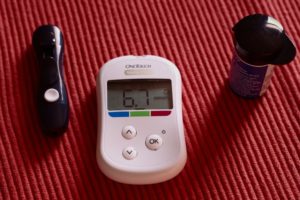In honor of National Diabetes Education Week, we thought we’d use our First Wednesday series to help spread awareness about diabetes, specifically in relation to HIV. We dedicated our first First Wednesday post to HIV, check it out here to refresh your memory. What we didn’t mention is how these two serious illnesses interact with one another.

The Basics
What is diabetes?
Our bodies break food down into glucose and send it to the blood. Glucose is used for energy right away or stored for later use. Diabetes is a disease in which the levels of glucose in the blood are too high.
There are two different types of diabetes. If you have type 1 diabetes, insulin is needed to keep a healthy level of glucose in the blood. You may have heard Type-1 called “juvenile diabetes” in the past, as up until recently it used to be the more common type of diabetes in children and teens. In type 2 diabetes, the body is incapable of producing enough insulin or using it effectively to maintain a healthy level of glucose in the blood. Type 2 used to be referred to as “adult-onset” diabetes, although it is now becoming more common across all age groups.
What are the risk factors for type 2 diabetes?
- Being age 45 or older
- Having a family history of diabetes
- Being overweight
- Being a member of certain racial and ethnic groups (e.g., African Americans, Hispanic/Latino Americans, Asian Americans, Pacific Islanders, and American Indians)
- Not exercising regularly
- Having a history of prediabetes
What are symptoms of diabetes?
- Unusual thirst
- Frequent urination
- Extreme hunger
- Unusual weight loss or weight gain
- Extreme fatigue and irritability
- Frequent infections
- Blurred vision
- Tingling or numbness in the hands and feet
- Slow healing of cuts or bruises
HIV and Diabetes
For people living with HIV, some HIV medicines may increase the risk of type 2 diabetes, so it’s important to understand the relationship between HIV and diabetes.
+ Person(s) living with HIV (PLHIV) are more likely to have type 2 diabetes than those who aren’t living with HIV.
+ PLHIV should be screened for diabetes before starting treatment. Certain HIV medicines can increase blood glucose levels and contribute to or lead to type 2 diabetes.
+ PLHIV should get their blood glucose levels checked regularly after starting a new medication. If the medication contributes to high glucose levels, talk to your doctor about changing treatment options.
+ If you are pregnant and treating HIV, you should get be screened for gestational diabetes at as early as 24 weeks gestation.
+ Type 2 diabetes can be treated and managed just like HIV can. Some ways to manage type 2 diabetes include:
- Maintaining a healthy diet including fruits, vegetables, whole grains, lean meats, beans, and nonfat or low-fat dairy products.
- Aiming for at least 30 minutes of physical activity of most days of the week
- Limiting foods that are are high in added sugars, salt, and saturated fat.

We want to encourage all of our DC Beings to take some time to learn more about diabetes this week. All information mentioned above came from The American Diabetes Association and the US Department of Health and Human Services.


